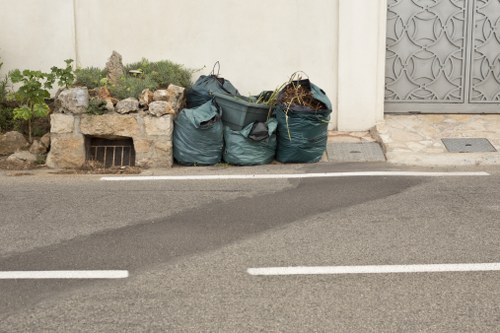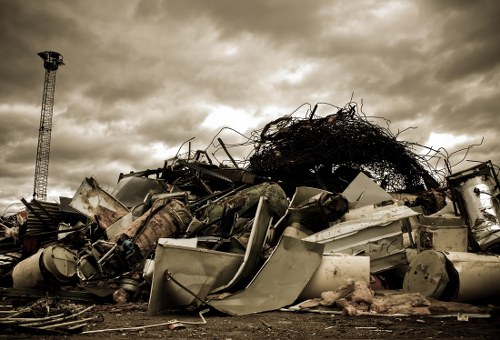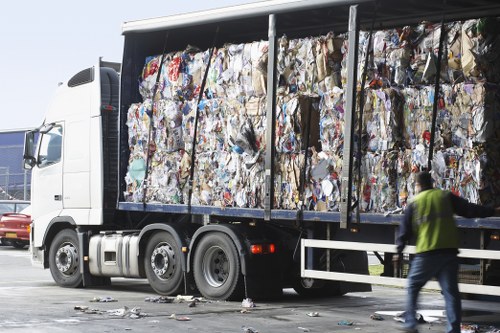Efficient Business Waste Removal in Mattress Disposal
Understanding the Importance of Mattress Disposal for Businesses

In the modern business landscape, sustainability and responsible waste management have become crucial elements for companies striving to minimize their environmental footprint. Among the various types of business waste, mattress disposal presents unique challenges and opportunities. Proper mattress disposal not only ensures compliance with environmental regulations but also enhances a company's reputation as a responsible corporate citizen.
Mattresses are bulky and often contain materials that can be harmful to the environment if not disposed of correctly. Businesses generate mattresses from office spaces, hotels, healthcare facilities, and other commercial establishments. Without an effective disposal strategy, these mattresses can contribute to landfills, causing long-term environmental damage.
Effective business waste removal in mattress disposal involves a comprehensive approach that includes recycling, repurposing, and responsible disposal methods. By adopting sustainable practices, businesses can reduce waste, conserve resources, and support a circular economy.
The Environmental Impact of Improper Mattress Disposal

Improper disposal of mattresses can have severe environmental consequences. Mattresses are composed of materials such as foam, fabric, springs, and chemicals, which are not easily biodegradable. When mattresses end up in landfills, they take up significant space and can take decades to decompose, if at all.
The decomposition process of mattresses releases harmful gases like methane, a potent greenhouse gas that contributes to climate change. Additionally, the leachate produced from decomposing mattresses can contaminate soil and groundwater, posing risks to ecosystems and human health.
Furthermore, the extraction and production of materials used in mattresses, including petroleum-based products, contribute to resource depletion and pollution. By ensuring proper mattress disposal, businesses can mitigate these environmental impacts and promote a healthier planet.
Challenges in Business Waste Removal for Mattress Disposal

Businesses face several challenges when it comes to waste removal in mattress disposal. The bulky nature of mattresses makes transportation and handling difficult, increasing costs and logistical complexities. Additionally, finding appropriate recycling facilities that can process mattresses effectively is often a significant hurdle.
Compliance with environmental regulations adds another layer of complexity. Businesses must navigate local, state, and federal laws regarding waste disposal, which can vary widely and change frequently. Failure to comply can result in hefty fines and damage to a company’s reputation.
Moreover, the lack of awareness and knowledge about sustainable disposal methods can impede efforts to implement effective waste removal strategies. Businesses need access to information and resources that guide them in making environmentally responsible decisions.
Strategies for Effective Mattress Disposal

To overcome the challenges associated with mattress disposal, businesses can adopt several strategies that promote sustainability and efficiency. One effective approach is partnering with specialized waste removal services that focus on mattress recycling and disposal.
- Recycling: Many components of mattresses, such as metal springs, foam, and fabrics, can be recycled. Businesses should work with waste removal companies that have the facilities and expertise to process these materials properly.
- Repurposing: Used mattresses can be repurposed for other uses, such as cushioning for playgrounds, pet bedding, or insulation materials for construction projects.
- Donation: Mattresses in good condition can be donated to charitable organizations, shelters, or non-profits that can distribute them to those in need.
Implementing a comprehensive mattress disposal plan that incorporates these strategies can significantly reduce environmental impact and enhance a business’s commitment to sustainability.
Choosing the Right Waste Removal Partner

Selecting the appropriate waste removal partner is critical for effective mattress disposal. Businesses should consider companies that offer specialized services in mattress recycling and have a proven track record of environmental responsibility.
Key factors to evaluate when choosing a waste removal partner include:
- Experience: Look for companies with extensive experience in mattress disposal and recycling.
- Compliance: Ensure the company adheres to all relevant environmental regulations and standards.
- Recycling Capabilities: Verify that the company has the facilities and processes in place to recycle mattress materials effectively.
- Customer Service: Choose a partner that offers reliable customer support and can customize services to meet your business’s specific needs.
By selecting a reputable waste removal partner, businesses can streamline their mattress disposal processes, ensure environmental compliance, and contribute to sustainable practices.
Benefits of Professional Mattress Disposal Services

Engaging professional mattress disposal services offers numerous benefits for businesses. These services provide expertise and resources that facilitate efficient waste removal, ensuring that mattresses are disposed of responsibly.
Some of the key benefits include:
- Efficiency: Professional services handle the logistics of mattress removal, saving businesses time and effort.
- Cost-Effective: By outsourcing disposal, businesses can avoid the costs associated with in-house waste management.
- Environmental Responsibility: Professional disposal ensures that mattresses are recycled or disposed of in an environmentally friendly manner.
- Compliance Assurance: Ensures adherence to all legal requirements, reducing the risk of penalties.
These advantages make professional mattress disposal services an essential component of a business’s waste management strategy.
Implementing a Sustainable Waste Management Plan

A sustainable waste management plan for mattress disposal involves several key steps that integrate environmental responsibility into a business’s operations.
Steps to implement include:
- Assessment: Evaluate the volume and types of mattresses your business needs to dispose of regularly.
- Planning: Develop a disposal plan that incorporates recycling, repurposing, and donation strategies.
- Partnership: Establish relationships with reliable waste removal partners who can support your disposal needs.
- Training: Educate staff on proper disposal practices and the importance of sustainability.
- Monitoring: Regularly review and assess the effectiveness of your waste management plan, making adjustments as necessary.
By following these steps, businesses can create a robust waste management plan that not only addresses mattress disposal but also promotes overall environmental stewardship.
Regulatory Compliance in Mattress Disposal

Compliance with environmental regulations is a crucial aspect of mattress disposal for businesses. These regulations are designed to protect the environment and public health by ensuring that waste is managed responsibly.
Businesses must be aware of and adhere to local, state, and federal laws governing waste disposal. Key regulations may include:
- Landfill Bans: Some regions prohibit the disposal of mattresses in landfills, requiring businesses to seek alternative disposal methods.
- Recycling Standards: Regulations may mandate the recycling of certain mattress components, such as metal springs and foam.
- Reporting Requirements: Businesses might need to report their waste disposal activities to regulatory bodies.
Failure to comply with these regulations can result in significant fines and legal repercussions. Therefore, partnering with a waste removal service that ensures regulatory compliance is essential for businesses.
Technological Innovations in Mattress Disposal

Advancements in technology have revolutionized the way businesses approach mattress disposal. Innovative recycling techniques and efficient waste management systems have made the process more sustainable and cost-effective.
Some notable technological innovations include:
- Automated Sorting: Advanced machinery can sort mattress materials quickly and accurately, increasing recycling efficiency.
- Material Separation: Technologies that separate different mattress components, such as metal, foam, and fabric, facilitate easier recycling and repurposing.
- Recycling Facilities: Modern recycling centers are equipped to handle large volumes of mattress waste with minimal environmental impact.
Embracing these technologies allows businesses to enhance their waste removal processes, reduce costs, and promote environmental sustainability.
Case Studies: Successful Mattress Disposal in Businesses

Many businesses have successfully implemented effective mattress disposal strategies, setting examples for others to follow. These case studies highlight the benefits and best practices of professional waste management.
Hospitality Industry: A chain of hotels partnered with a specialized waste removal service to manage their mattress disposal. By recycling materials and donating usable mattresses, they reduced their environmental footprint and increased operational efficiency.
Healthcare Facilities: A large hospital implemented a comprehensive waste management plan that included mattress disposal. By adhering to regulatory standards and utilizing advanced recycling technologies, the hospital ensured safe and responsible disposal of medical-grade mattresses.
These examples demonstrate that with the right strategies and partnerships, businesses can overcome the challenges of mattress disposal and achieve sustainable waste management goals.
Future Trends in Mattress Disposal

The field of mattress disposal is continually evolving, with new trends emerging to enhance sustainability and efficiency. Staying informed about these trends can help businesses stay ahead in their waste management practices.
Future trends include:
- Increased Recycling Rates: Advances in recycling technology are expected to further increase the percentage of mattress materials that can be recycled.
- Circular Economy Models: Businesses are adopting circular economy principles, ensuring that mattress materials are reused and recycled rather than discarded.
- Digital Tracking: Implementation of digital tracking systems to monitor mattress disposal processes, ensuring transparency and compliance.
By embracing these trends, businesses can enhance their mattress disposal practices, contributing to a more sustainable and environmentally friendly future.
Cost Considerations in Mattress Disposal

Cost is a significant factor for businesses when it comes to waste removal in mattress disposal. Effective cost management can help businesses implement sustainable disposal practices without straining their budgets.
Businesses should consider the following cost factors:
- Transportation Costs: The size and weight of mattresses can increase transportation expenses. Partnering with local waste removal services can help minimize these costs.
- Recycling Fees: Some recycling facilities charge fees based on the volume and type of materials processed.
- Labor Costs: Handling and preparing mattresses for disposal may require additional labor, impacting overall costs.
To manage these expenses effectively, businesses can negotiate contracts with waste removal partners, explore bulk disposal discounts, and implement in-house sorting to reduce processing fees.
Implementing Best Practices for Mattress Disposal

Adopting best practices in mattress disposal can significantly enhance the efficiency and sustainability of a business’s waste management strategy. These practices ensure that mattresses are disposed of responsibly while maximizing resource recovery.
Best practices include:
- Sort Before Disposal: Separate different mattress components to facilitate recycling and repurposing.
- Use Eco-Friendly Materials: Whenever possible, opt for mattresses made from recyclable or biodegradable materials.
- Track Disposal Activities: Maintain records of mattress disposal to ensure compliance and identify areas for improvement.
- Engage Employees: Educate and involve staff in sustainable disposal practices to foster a culture of environmental responsibility.
Implementing these best practices helps businesses achieve their sustainability goals and reduce their overall environmental impact.
Maximizing Resource Recovery from Mattresses

Maximizing resource recovery from mattresses is a key component of sustainable waste management. By extracting valuable materials, businesses can reduce waste and contribute to the creation of new products.
Strategies to maximize resource recovery include:
- Material Separation: Efficiently separating metal springs, foam, and fabrics to enable their recycling or repurposing.
- Partnerships with Recyclers: Collaborating with recycling facilities that specialize in mattress materials to ensure high recovery rates.
- Innovative Repurposing: Finding creative ways to reuse mattress materials in other industries, such as construction, automotive, or furniture manufacturing.
By focusing on resource recovery, businesses can not only reduce their waste but also support the development of a circular economy.
Promoting Sustainability Through Mattress Disposal

Promoting sustainability through mattress disposal is essential for businesses committed to environmental stewardship. Sustainable disposal practices demonstrate a company's dedication to reducing its ecological footprint and can enhance its reputation among consumers and stakeholders.
Ways to promote sustainability include:
- Adopting Green Practices: Incorporate environmentally friendly disposal methods into the business’s standard operating procedures.
- Educating Stakeholders: Inform employees, customers, and partners about the importance of sustainable mattress disposal.
- Setting Sustainability Goals: Establish clear targets for reducing waste and increasing recycling rates.
By prioritizing sustainability in mattress disposal, businesses can contribute to a healthier planet and achieve long-term operational success.
Conclusion: Commitment to Responsible Mattress Disposal

Effective business waste removal in mattress disposal is a critical aspect of responsible environmental management. By understanding the importance, overcoming challenges, and implementing sustainable strategies, businesses can ensure that their mattress disposal practices contribute positively to the environment and society.
Partnering with specialized waste removal services, adopting best practices, and staying informed about technological advancements and regulatory changes are essential steps in this journey. The commitment to responsible mattress disposal not only benefits the environment but also enhances a business's reputation and operational efficiency.
Embrace sustainable mattress disposal today and take a proactive role in building a greener, more sustainable future for your business and the planet.
Contact us today to learn more about our professional mattress disposal services and how we can help your business achieve its sustainability goals.